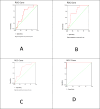The predictive value of combined insulin resistance and β-cell secretion in Yemeni school-aged children for type 2 diabetes mellitus
- PMID: 39747350
- PMCID: PMC11697439
- DOI: 10.1038/s41598-024-84349-5
The predictive value of combined insulin resistance and β-cell secretion in Yemeni school-aged children for type 2 diabetes mellitus
Abstract
The present study aimed to determine the predictive power of the diabetic markers and metabolic syndrome factors in School-aged children for developing Type 2 DM. In this cross-sectional study, 1288 students aged 12-13 were recruited from public schools in the capital city of Sana'a. Anthropometric measurements and blood pressure were recorded and body mass index (BMI) was calculated. Fasting venous blood (5 ml) was collected for biochemical analysis including FBG, HbA1c, insulin, and lipid profile. Insulin resistance (HOMA-IR) and β-cell function (HOMA-β) were calculated. Our results showed that neither insulin, HOMA-IR nor HOMA-β individually were good predictors for Type 2 DM as assessed by the ROC curve with AUC < 0.75. However, the ROC curve of combined HOMA-IR and HOMA-β (Model 1) gave a superior AUC of 0.998 (p = 2.7 × 10-9) and predicted 140 (10.9%) children to develop Type 2 DM. This model picked up all impaired fasting glucose (IFG), 74% of metabolic glucose, and 71% of metabolic syndrome (MetS) groups. On the other hand, the ROC curve for metabolic syndrome (Model 2) gave an AUC of 0.751 (p = 0.003) and predicted a higher number of 416 (32.3%) children to develop prediabetes and Type 2 DM. This model picked up 75% of IFG, 71% of MetS, 82% of those having two factors of MetS, and 72% of obesity groups. Moreover, the 53 children common between the two models include 75% of IFG and 43% of MetS groups. Therefore, the combined HOMA-IR and HOMA-β model in children proved to be a good predictor for Type 2 DM development, whereas the MetS model predicts the development of prediabetes and Type 2 DM.
Keywords: Insulin resistance; Metabolic syndrome; Prediabetes; School-aged children; Type 2 DM; Β-cell function.
© 2024. The Author(s).
Conflict of interest statement
Competing interests: The authors declare no competing interests. Ethics approval and consent to participate: The study protocol was approved by the Institutional Ethical Committee, Faculty of Medicine and Health Sciences, Sana`a University. The study was in compliance with the Declaration of Helsinki for clinical research. All the recruited participants provided written informed consent from their parents and/ or their legal guardians before participating in the study.
Figures
Similar articles
-
Metabolic Syndrome and Prediabetes Among Yemeni School-Aged Children.Diabetes Metab Syndr Obes. 2020 Jul 20;13:2563-2572. doi: 10.2147/DMSO.S260131. eCollection 2020. Diabetes Metab Syndr Obes. 2020. PMID: 32765035 Free PMC article.
-
Impact of triglycerides and waist circumference on insulin resistance and β-cell function in non-diabetic first-degree relatives of type 2 diabetes.BMC Endocr Disord. 2021 Jun 16;21(1):124. doi: 10.1186/s12902-021-00788-5. BMC Endocr Disord. 2021. PMID: 34134670 Free PMC article.
-
Obesity, metabolic syndrome, and insulin resistance in urban high school students of minority race/ethnicity.Arch Pediatr Adolesc Med. 2012 Nov;166(11):1030-6. doi: 10.1001/archpediatrics.2012.1263. Arch Pediatr Adolesc Med. 2012. PMID: 23007727 Free PMC article.
-
Superiority of the triglyceride glucose index over the homeostasis model in predicting metabolic syndrome based on NHANES data analysis.Sci Rep. 2024 Jul 5;14(1):15499. doi: 10.1038/s41598-024-66692-9. Sci Rep. 2024. PMID: 38969755 Free PMC article.
-
Screening accuracy of Single-Point Insulin Sensitivity Estimator (SPISE) for metabolic syndrome: a systematic review and meta-analysis.BMC Endocr Disord. 2025 Jun 6;25(1):142. doi: 10.1186/s12902-025-01957-6. BMC Endocr Disord. 2025. PMID: 40481439 Free PMC article.
References
-
- Dean, H. J. & Sellers, E. A. Children have type 2 diabetes too: an historical perspective. Biochem. Cell. Biol.93(5), 425–429 (2015). - PubMed
-
- Zeitler, P. et al. ISPAD Clinical practice consensus guidelines 2018: type 2 diabetes mellitus in youth. Pediatr. Diabetes. 19(Suppl. 27), 28–46 (2018). - PubMed
MeSH terms
Substances
LinkOut - more resources
Full Text Sources
Medical



